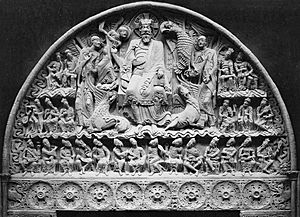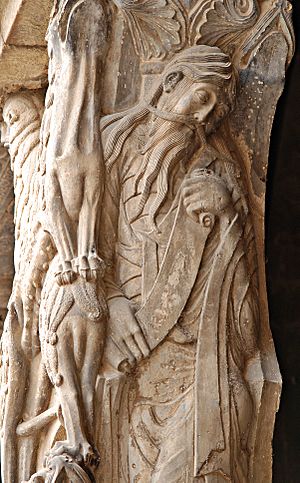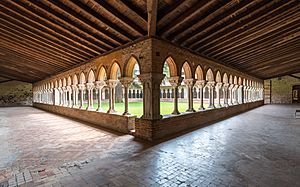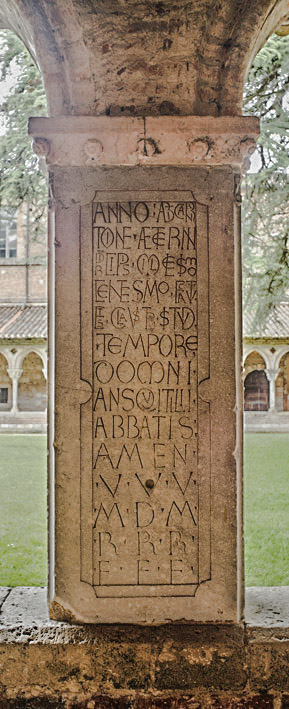Moissac Abbey facts for kids
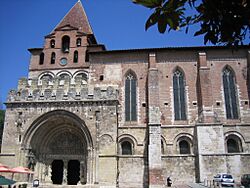
The Romanesque south door of the abbey church
|
|
| Monastery information | |
|---|---|
| Other names | Abbaye Saint-Pierre de Moissac |
| Order | Benedictine |
| Dedicated to | Saint Peter |
| People | |
| Founder(s) | Clovis I |
| Architecture | |
| Style | Gothic architecture Romanesque architecture |
| Site | |
| Location | Moissac, Tarn-et-Garonne |
| Country | France |
| Coordinates | 44°6′20″N 1°5′5″E / 44.10556°N 1.08472°E |
Moissac Abbey is a very old and important monastery located in Moissac, a town in southwestern France. For many centuries, it was home to monks of the Benedictine order. Today, some of its amazing medieval buildings are still standing. This includes the abbey church, which is famous for its beautiful Romanesque sculptures around the main entrance.
Contents
History of Moissac Abbey
How the Abbey Started
There's a cool legend about how Moissac Abbey began. It says that a Frankish king named Clovis I founded it in 506. This was the day after he won a big battle against the Visigoths. The story goes that Clovis promised to build a monastery with 1,000 monks if he won. This was to remember the thousand warriors he lost in the fight. He even threw his spear from a hill to mark the spot. But the spear landed in a swamp!
However, history books tell us that the abbey was actually founded by Saint Didier. He was a bishop from Cahors, and he started the monastery in the middle of the 7th century.
The early years of the monastery were tough. It faced many attacks from different groups. Moors from the south and west raided it twice around 732. Later, Norman pirates and Hungarians also looted the abbey in the 9th and 10th centuries.
A New Beginning in the 11th Century
The 11th century was a challenging but important time for Moissac Abbey. In 1030, the roof of the church fell in because it hadn't been looked after. Then, in 1042, a serious fire broke out.
To fix these problems and help the monks follow their rules better, a big change happened. In 1047, the abbot of Cluny (a very important monastery) was asked to help. He brought in new rules and helped restore the abbey.
A brand new church building was added in 1063, and many parts of the abbey were repaired. In 1097, Pope Urban II himself visited Moissac. He blessed the main altar and ordered the building of the beautiful cloister. This cloister was finished by the year 1100.
The Golden Age of the 12th Century
The 11th and 12th centuries were like a "golden age" for Moissac Abbey. It became closely connected to Cluny Abbey, which was a very powerful monastery. This connection brought new rules and helped Moissac become one of the most important abbeys in France.
Its location was also key, as it was on a popular pilgrim road. This meant many travelers passed through and supported the abbey. During this time, the abbot of Moissac was almost as important as the abbot of Cluny itself!
Important leaders like Dom Hunaud de Gavarret and Dom Ansquitil guided the abbey. They were responsible for building the famous doorway and its amazing sculptures. Monks at the abbey also created beautiful handwritten books with colorful pictures, called illuminated manuscripts. These books are now kept in a national library in Paris.
Changes in the 15th Century and Beyond
The 15th century brought another period of growth for the abbey. Abbots Pierre and Antoine de Caraman led new building projects. They added the beautiful Gothic parts of the abbey church.
However, in 1626, the Benedictine monks had to leave the cloister. They were replaced by another group of religious people called Augustinian canons.
Then came the French Revolution in 1793. This event completely ended monastic life at Moissac. The abbey church of St Pierre is still standing and is used as a church today. However, many of the other abbey buildings were damaged or destroyed.
In the mid-1800s, a railway line was planned right through the cloister! Luckily, the cloister was saved, though the dining hall was taken down for the railway. The abbey was then listed as a historic monument. Since 1998, the church and cloisters have been protected as a World Heritage Site. They are part of the "Routes of Santiago de Compostela in France", which are old pilgrim routes.
Amazing Architecture
Moissac Abbey is famous for its incredible architecture and sculptures.
The South-West Portico
One of the most interesting parts is the church's south-west portico. This is a special entrance area with a crenellated (castle-like) roof. It features some of the best Romanesque art in the world. This shows how much sculpture was used on the outside of churches during that time.
The Tympanum and Trumeau
Above the main doorway, you'll see a large carved area called a tympanum. This amazing sculpture shows scenes from the Apocalypse in the Bible's Book of Revelation.
Supporting the tympanum is a central pillar called a trumeau. On this pillar, there's a stunning statue of the Prophet Isaiah. It's a fantastic example of Romanesque sculpture, similar to other famous works from that period.
The Cloisters
The cloisters (a covered walkway around a courtyard) of Moissac Abbey are also filled with beautiful Romanesque sculptures. You can see many carved pillars and designs there.
See also
 In Spanish: Abadía de Moissac para niños
In Spanish: Abadía de Moissac para niños
- French Romanesque architecture


